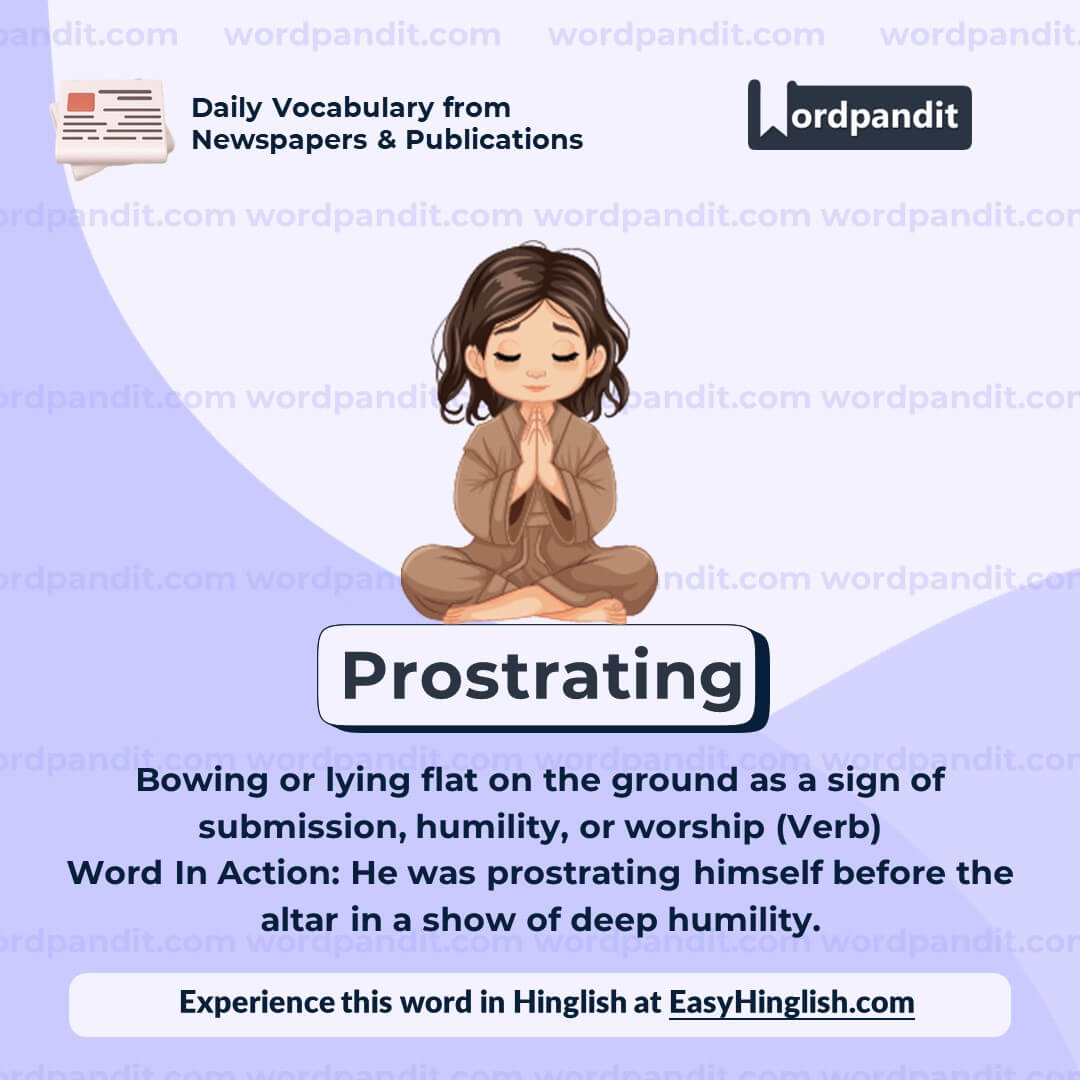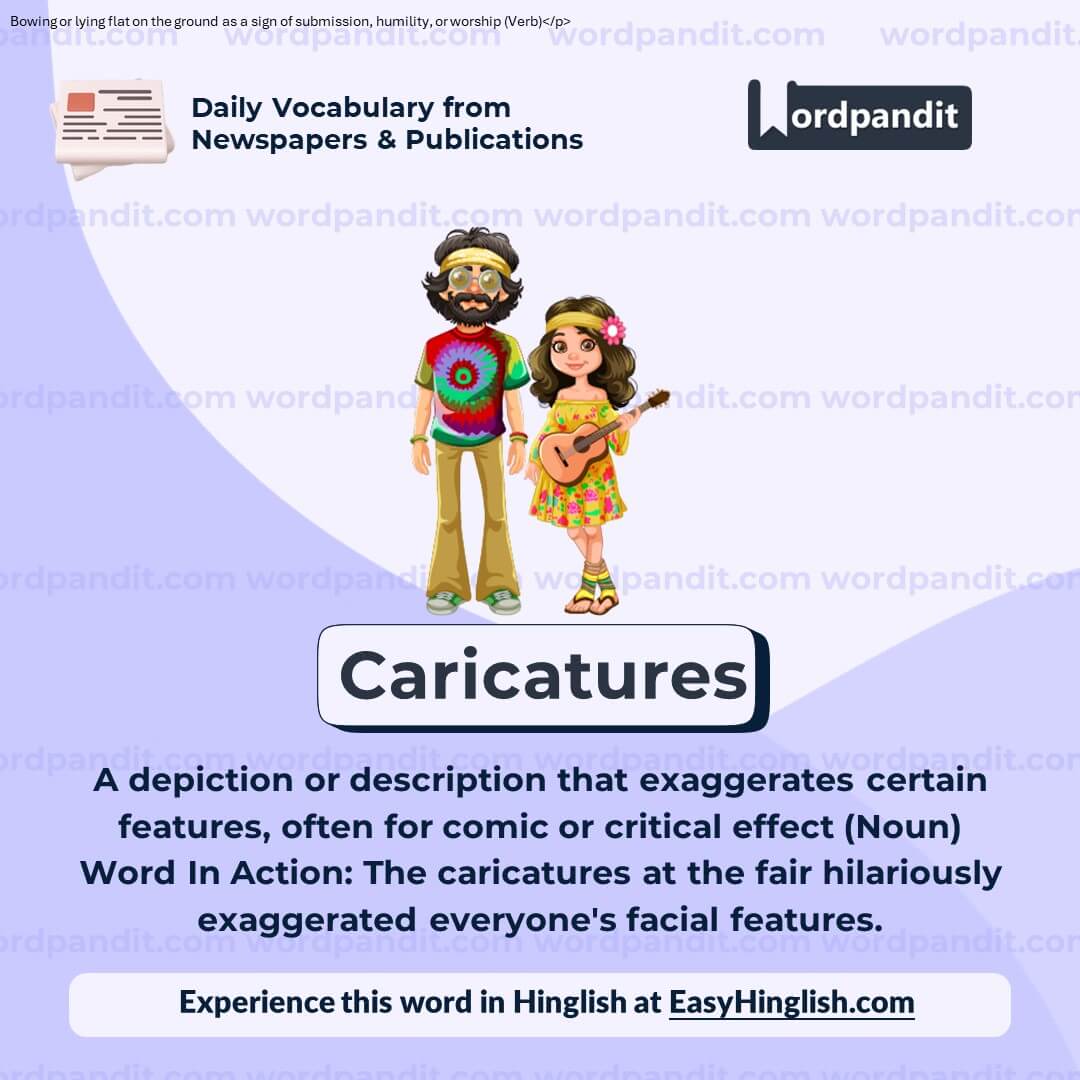Daily Vocabulary from Indian Newspapers and Publications
Welcome to Wordpandit’s Indian Vocabulary Hub
At Wordpandit, we understand the importance of staying rooted in the local context while expanding your language skills. This section focuses on enriching your vocabulary with words and phrases drawn from India’s leading newspapers and publications, ensuring you're learning vocabulary that is practical, relevant, and uniquely Indian.
Why Indian Sources Matter
We believe that the best way to master any language is by immersing yourself in local content. That’s why we carefully curate vocabulary from top Indian publications, including:
- The Hindu
- The Times of India
- The Economic Times
- Hindustan Times
- Live Mint
- The Indian Express
- And many others...
Stay Updated, Stay Relevant
With daily updates from Indian news sources, you’ll be consistently learning words that reflect the trends and shifts in Indian society and culture. Our focus is to provide vocabulary that enhances your understanding of the language in an Indian context.
How Wordpandit Supports Your Goals
Whether you’re preparing for exams, aiming to improve your professional communication, or simply want to stay connected with the latest Indian vocabulary, Wordpandit is here to guide you every step of the way.
Learn with a Practical Approach
Our interactive learning methodology includes real-world examples, engaging activities, and context-specific usage to ensure that every word becomes part of your active vocabulary.
Dive into Indian Vocabulary Today!
Why Choose Wordpandit?
Practical Learning: Focus on words you'll actually encounter in real-world reading, enhancing your comprehension and communication skills.
Diverse Content: From current affairs to scientific breakthroughs, our varied sources expose you to vocabulary across multiple domains.
Effortless Integration: Make Wordpandit a part of your daily routine. Just a few minutes each day can significantly boost your lexicon over time.
Your Path to Vocabulary Mastery
- Visit our Daily Vocabulary section regularly
- Explore new words and their usage in context
- Practice incorporating these words into your own writing and speech
- Track your progress as your vocabulary expands
Start Your Journey Today
Embark on your vocabulary enhancement journey with Wordpandit. By consistently engaging with our daily posts, you'll build a robust vocabulary that serves you well in academic, professional, and personal contexts.
Remember, a word a day keeps linguistic limitations at bay. Make Wordpandit your daily companion in the quest for vocabulary excellence!
WORD-1: Seminal
Context:
"Conferred the Padma Shri, his legacy includes his seminal translation of a 17th century Latin classic into English and subsequently Malayalam, besides mentoring multiple generations of students." - The Indian Express
Explanatory Paragraph:
The word "seminal" refers to something that is highly influential, groundbreaking, or serving as the foundation for future development. Often used in intellectual, creative, or scientific contexts, it denotes ideas, works, or contributions that have a profound and lasting impact.
Meaning: Highly influential, groundbreaking, or foundational in a field (Adjective)
Pronunciation: SEM-uh-nuhl
Difficulty Level: ⭐⭐⭐ Intermediate
Etymology: Derived from the Latin word "semen," meaning "seed," indicating something that acts as a seed for future growth or ideas.
Synonyms & Antonyms:
Synonyms: Influential, groundbreaking, pivotal, foundational, innovative
Antonyms: Insignificant, unimportant, trivial, inconsequential
Usage Examples:
- Her seminal research paper introduced a new paradigm in quantum physics.
- The artist's seminal work paved the way for modern abstract painting.
- The documentary is considered a seminal piece in environmental activism.
- His seminal contributions to mathematics earned him a prestigious award.
Cultural Reference:
"The book 'A Brief History of Time' by Stephen Hawking is considered a seminal work that popularized complex scientific theories for a general audience." - Popular Science
Think About It:
What makes a work, idea, or contribution "seminal," and how do societal values influence this designation?
Quick Activity:
List three works of literature, art, or science you believe are seminal and explain why you think so.
Memory Tip:
Think of "seminal" as related to "seed." Just as a seed is the starting point for growth, a seminal idea or work is the starting point for significant progress or change.
Real-World Application:
The term "seminal" is widely used in academia, science, and the arts to describe work that has a transformative influence, often shaping future research, practices, or cultural trends.
WORD-2: Incinerator
Context:
"On Wednesday, around 337 tonnes of toxic waste was taken from the Union Carbide plant to an incinerator facility around 230km (143 miles) away after a court last month set a four-week deadline for it to be disposed of." - The Wire
Explanatory Paragraph:
An "incinerator" is a specialized facility or device used to burn waste materials at high temperatures. This process is often employed for disposing of hazardous or non-recyclable waste in a way that reduces volume and neutralizes harmful substances. Incinerators are commonly used in waste management to safely dispose of materials that cannot be easily processed by other methods.
Meaning: A facility or device used for burning waste at high temperatures (Noun)
Pronunciation: in-sin-uh-ray-tur
Difficulty Level: ⭐⭐⭐ Intermediate
Etymology: From Latin "incinerare," meaning "to reduce to ashes," derived from "in-" (into) + "cinis" (ashes).
Synonyms & Antonyms:
Synonyms: Furnace, crematory, combustion chamber
Antonyms: Recycler, landfill
Usage Examples:
- The city installed a new incinerator to manage its growing waste problem.
- The toxic materials were transported to an incinerator for safe disposal.
- The old documents were burned in an industrial incinerator.
- Environmental activists raised concerns about emissions from the incinerator.
Cultural Reference:
Incinerators are frequently depicted in movies and literature as tools for destroying evidence or handling waste in dystopian settings, symbolizing destruction and irreversible change.
Think About It:
What are the pros and cons of using incinerators for waste management, and how can we balance efficiency with environmental concerns?
Quick Activity:
Research the nearest incinerator facility to your location. What kind of waste does it handle, and how does it ensure environmental safety?
Memory Tip:
Remember "incinerator" by associating it with "cinders," as both relate to burning and ashes.
Real-World Application:
Incinerators are crucial in managing waste from hospitals, industries, and cities, ensuring the safe disposal of materials that could otherwise pose health and environmental risks.
WORD-3: Pompous
Context:
"The purpose of political cartoons is to prick pomposity and cut those who rule over us – or aspire to – down to size. India, the US and the UK all have rich traditions of cartooning and caricatures." - The Wire
Explanatory Paragraph:
The word "pompous" describes someone who is overly self-important and exhibits an exaggerated sense of dignity, often in a way that comes across as arrogant or pretentious. Such individuals might use grandiose language or act superior, making them targets for humor and criticism, particularly in satire.
Meaning: Overly self-important and arrogant in speech or manner (Adjective)
Pronunciation: pom-puhs
Difficulty Level: ⭐⭐⭐ Intermediate
Etymology: Derived from the Late Latin "pompa," meaning "procession" or "display," which evolved into "pomp" in Middle English, reflecting grandeur or ostentation.
Synonyms & Antonyms:
Synonyms: Arrogant, pretentious, conceited, grandiose
Antonyms: Humble, modest, unassuming, down-to-earth
Usage Examples:
- The pompous professor dismissed any questions from his students as beneath him.
- Her pompous speech about her achievements left the audience unimpressed.
- The actor's pompous attitude during the interview sparked criticism online.
- The novel humorously depicts a pompous politician who takes himself far too seriously.
Cultural Reference:
In Jane Austen's *Pride and Prejudice*, Mr. Collins is a classic example of a pompous character, often ridiculed for his self-importance and lack of self-awareness.
Think About It:
Why do you think society often mocks pompous behavior? Is it a way of encouraging humility in leaders and public figures?
Quick Activity:
Write a brief description or dialogue for a pompous character in a story or cartoon. How would they speak and act?
Memory Tip:
Think of the word "pomp" as a showy display, and imagine a pompous person making a big display of their importance.
Real-World Application:
The word "pompous" is often used in critiques of leadership, social interactions, or even art, pointing out behavior or attitudes that are excessively grandiose or self-important.
WORD-4: Prostrating
Context:
"And Mickey Mouse, the corporate mascot of Disney (which now controls ABC and other TV networks), is depicted prostrating himself at the feet of the new leader." - The Wire
Explanatory Paragraph:
"Prostrating" refers to the act of bowing or lying flat on the ground as a gesture of respect, submission, or worship. It can also be used metaphorically to describe extreme deference or subservience. The term often conveys a sense of humility or self-abasement, whether in a literal or figurative sense.
Meaning: Bowing or lying flat on the ground as a sign of submission, humility, or worship (Verb)
Pronunciation: pros-tray-ting
Difficulty Level: ⭐⭐⭐ Intermediate
Etymology: From the Latin "prostrare," meaning "to throw down," from "pro-" (before) + "stare" (to stand).
Synonyms & Antonyms:
Synonyms: Bowing, kneeling, submitting, groveling
Antonyms: Upright, standing, resisting, defying
Usage Examples:
- The devotees were prostrating themselves before the sacred altar in prayer.
- In the story, the knight was depicted as prostrating himself before the king in a show of loyalty.
- The political cartoon mocked the leader by showing his followers prostrating in exaggerated reverence.
- After his defeat, he seemed almost prostrating in his eagerness to please his adversaries.
Cultural Reference:
Prostration is a significant gesture in many religious practices, including Islam, where it is performed during prayer, and Buddhism, where it symbolizes devotion and humility.
Think About It:
Why do you think physical gestures like prostrating are such powerful symbols of submission or reverence in human culture?
Quick Activity:
Think of a moment in history or fiction where someone prostrated themselves. What was the significance of this act in that context?
Memory Tip:
To remember "prostrating," think of "pro" (forward) and "strating" (lying straight), which together suggest lying flat in submission or respect.
Real-World Application:
The concept of prostration is often used in leadership studies or psychology to discuss power dynamics, deference, and the role of nonverbal communication in human interactions.
WORD-5: Caricatures
Context:
"The purpose of political cartoons is to prick pomposity and cut those who rule over us – or aspire to – down to size. India, the US and the UK all have rich traditions of cartooning and caricatures." - The Wire
Explanatory Paragraph:
A "caricature" is a visual or written representation that exaggerates specific features or traits of a person or thing, often for comedic or satirical effect. Caricatures are commonly used in art, literature, and media to highlight flaws, poke fun at prominent figures, or make social commentary.
Meaning: A depiction or description that exaggerates certain features, often for comic or critical effect (Noun)
Pronunciation: kar-i-kuh-churz
Difficulty Level: ⭐⭐ Beginner
Etymology: Derived from the Italian "caricatura," meaning "exaggeration," from "caricare" (to load or exaggerate).
Synonyms & Antonyms:
Synonyms: Parody, satire, lampoon, cartoon
Antonyms: Realistic depiction, true portrayal, authentic representation
Usage Examples:
- The caricature of the politician exaggerated his large nose and stern expression for comedic effect.
- In the gallery, the caricatures of famous celebrities drew the most laughter from visitors.
- The editorial page often features caricatures of public figures to accompany its satirical articles.
- Her caricature of her boss at the office party was so accurate it made everyone burst into laughter.
Cultural Reference:
Caricatures have a long history in political satire, with artists like James Gillray and Honoré Daumier using them in the 18th and 19th centuries to critique powerful figures and social issues.
Think About It:
Why do you think caricatures are such effective tools for criticism and humor? What makes exaggeration a powerful form of communication?
Quick Activity:
Sketch or describe a caricature of someone you admire. Which features would you exaggerate, and why?
Memory Tip:
Remember "caricature" by associating it with "character" – it’s a playful exaggeration of a character's features or personality.
Real-World Application:
Caricatures are used in political cartoons, comedy shows, and editorial illustrations to provoke thought, entertain, and critique public figures or societal trends.
















